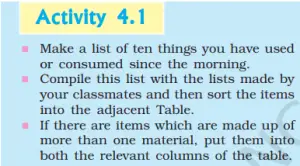Activity 4.1 in Chapter 4 of the NCERT Class 10 Science book
IN this article learn about Activity 4.1 for class 10 science. It encourages students to discover how carbon compounds are found all around them in their daily lives.

Aim
This activity will help you discover how many things you use every day have presence of carbon compounds in them.
Activity 4.1
- Make a list of ten things you have used or consumed since the morning.
- Compile this list with the lists made by your classmates and then sort the items into the following table.
- If there are items that are made up of more than one material, put them into both the relevant columns.
Answer to the activity
| Things made of metal | Things made of glass/clay | Others |
| Utensils | Utensils | Food |
| Mobile phone | Watch | Book |
| Key-chain | Aquarium | Pen |
| Fridge | Test tube | Bottle |
| Fan | Mirror | Washing machine |
| Nail cutter | Bag | |
| Scissors | Cloth | |
| Wood door & windows | ||
| Toys |
Discussion and Conclusion
The activity leads to an important realization:
- A large number of things we use daily, including various food items, are made up of compounds of carbon.
- These carbon compounds are called organic compounds.
- This vast presence of organic compounds signifies their importance in our life.
Questions for Reflection
- What properties of carbon allow it to form a multitude of compounds?
- Can petroleum and fossil fuels be classified as carbon compounds?
- What are some common examples of carbon compounds in our daily life?
Answers to Reflection Questions
- Carbon has a unique ability to form strong covalent bonds with other carbon atoms and with atoms of other elements. This is due to its four valence electrons, which allow it to form four covalent bonds.
- Yes, both petroleum and fossil fuels are classified as carbon compounds. They are primarily composed of hydrocarbons, which are compounds made up of carbon and hydrogen atoms. These hydrocarbons can exist in various forms, such as gases, liquids, or solids, depending on their molecular structure.
- Common examples of carbon compounds in our daily life include
- carbon dioxide (exhaled by humans and animals),
- glucose (a primary source of energy for our bodies),
- cellulose (found in plants and vegetables), and
- various hydrocarbons like methane (found in natural gas) and petrol.
This activity helps us in understanding the fundamental role of carbon in the world around us.
Related Content
 Skip to content
Skip to content